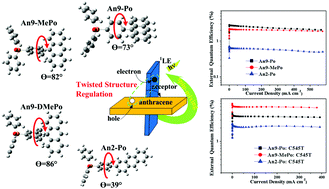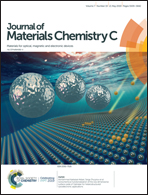Strategy for achieving efficient electroluminescence with reduced efficiency roll-off: enhancement of hot excitons spin mixing and restriction of internal conversion by twisted structure regulation using an anthracene derivative†
Abstract
Phosphorescent and thermally activated delayed fluorescence (TADF) emitters have met a bottleneck due to the efficiency roll-off problem caused by the accumulation of the lowest triplet excited states with a relatively long lifetime. To achieve a high performance electroluminescence (EL) device with a simultaneously high radiative exciton ratio and a low efficiency roll-off in lighting applications at high luminance, we have demonstrated a novel strategy to construct an efficient hot exciton channel by effective spin mixing of the high-lying singlet and the triplet charge transfer (CT) excited states and restriction of the internal conversion (IC) from the high-lying triplet CT state to the lower triplet state. We selected luminous anthracene and electron-withdrawing triphenylphosphine oxide groups with a high triplet energy level to build four moderated D–A structure molecules which possess a high-lying CT hot exciton. Furthermore, the electronic coupling between the D and A unit can be precisely reduced by means of twisted structure regulation. In our series of novel synthesized materials, 9-[4-(diphenyl-phosphinoyl)-2-methyl-phenyl]-anthracene (An9-MePo) achieved optimization of the hot exciton radiation process and restriction of the IC. Both the maximum radiative exciton ratio of 74% and 72%, and the low efficiency roll-off of 10.6% and 15.9% at a luminance of 10 000 cd m−2 were achieved in a practical lighting application by the An9-MePo based nondoped and doped EL devices, respectively. Our results provide a novel approach to the fabrication of an efficient hot exciton channel, proving the great potential of this EL molecule design strategy for practical lighting applications.



 Please wait while we load your content...
Please wait while we load your content...